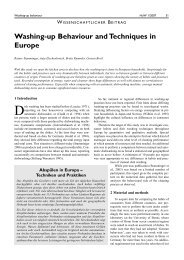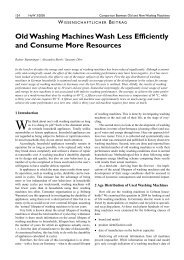Development of a novel mechatronic system for mechanical weed ...
Development of a novel mechatronic system for mechanical weed ...
Development of a novel mechatronic system for mechanical weed ...
Create successful ePaper yourself
Turn your PDF publications into a flip-book with our unique Google optimized e-Paper software.
Results and discussion<br />
outputs from the servo drive were data from the incremental encoder and alarm<br />
signals.<br />
The motor’s rated (maximum) speed is 1,500 rpm and the equivalent rated<br />
speed <strong>of</strong> the hoe is<br />
u<br />
hmax<br />
ummax<br />
1500<br />
= = = 60 rpm = 1 rps<br />
(5.14)<br />
G 25<br />
To define the adequate voltage/speed ratio the speed reference input gain<br />
Pn300 in the servo drive needed to be adjusted. The parameter Pn300 has a<br />
setting range between 150 and 3000 and corresponds to the input voltage V-<br />
REF with the ratio 100 to 1. E.g. if the Pn300 is adjusted to 600, the rated speed<br />
will be achieved with V-REF equal to 6 V.<br />
The servo ON signal is required as a main signal <strong>for</strong> starting the servo motor. In<br />
the case where this signal is “low” the servo motor cannot be controlled with<br />
external signals.<br />
To receive appropriate in<strong>for</strong>mation about the position <strong>of</strong> the motor and<br />
accordingly the angular position <strong>of</strong> the hoeing tool, in relation to the “zero”<br />
position, the encoder dividing ratio was set to 24 pulses per rotation. Hence the<br />
gear ratio is G=25, 600 pulses correspond to one full rotation <strong>of</strong> the hoeing tool<br />
and this represents the resolution <strong>of</strong> the hoeing tool <strong>system</strong> RESsys.<br />
5.3.3 Discussion <strong>of</strong> the distance between the plant<br />
detection unit and the plane in which the hoeing<br />
tool is positioned<br />
The rotational speed <strong>of</strong> the hoeing tool is directly proportional to the <strong>for</strong>ward<br />
speed <strong>of</strong> the carrier. For travelled distances which are short, speed can be<br />
approximated with a constant value as shown in Equation (5.15).<br />
∂s ∆s<br />
V = ≅<br />
∂t ∆ t<br />
(5.15)<br />
91





